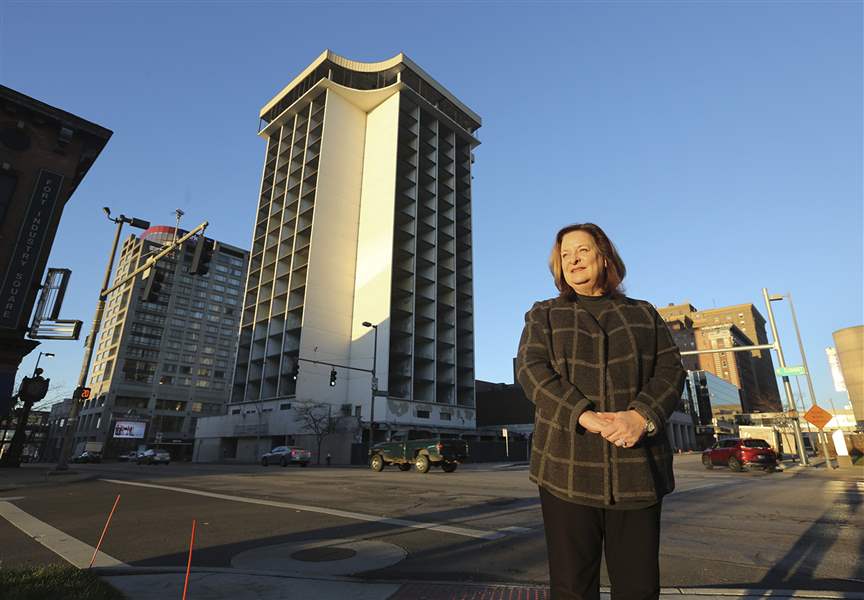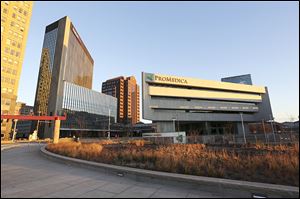
Hotel Seagate renovation builds hope for revival of downtown Toledo
Experts: Hotel Seagate’s rehab to aid tourism, help downtown’s rebirth
12/2/2017
With the former Seagate Hotel behind her, Lucas County Commissioner Carol Contrada is pictured on Summit Street Friday, December 1, 2017 in downtown Toledo. The county commissioners announced Tuesday a partnership with Key Hotel and Property Management LLC to redevelop the partially demolished, county-owned 19-story building at 127 N. Summit St. into a “dual brand” Hilton Garden Inn and Homewood Suites.
THE BLADE/DAVE ZAPOTOSKY
Buy This Image
Tourism is a giant economic engine in Lucas County, generating $2 billion in business activity in 2015 and supporting 1 in every 11 jobs in the county.
But a study conducted last year by the 22nd Century Committee said that engine could be much bigger — and having more than 600 committable hotel rooms would allow Toledo to be more competitive for convention business.
“Basically, if you’ve got a group that needs 600 committable rooms and you have only 400, then you can’t fish in that pond,” said Tony Vetter, director of sales for Destination Toledo, the area’s tourism and convention bureau.

With the former Seagate Hotel behind her, Lucas County Commissioner Carol Contrada is pictured on Summit Street Friday, December 1, 2017 in downtown Toledo. The county commissioners announced Tuesday a partnership with Key Hotel and Property Management LLC to redevelop the partially demolished, county-owned 19-story building at 127 N. Summit St. into a “dual brand” Hilton Garden Inn and Homewood Suites.
Since the former 262-room Hotel Seagate fell into financial trouble, then closed in 2009, downtown Toledo has been below that 600-room threshold. Only the 294-room Park Inn by Radisson and the 241-room Renaissance Toledo Downtown hotel, which had operated under several hotel names, were available to accept travelers.
But the announcement Tuesday that Lucas County officials will collaborate with developer Key Hotel and Property Management LLC on a $30-million investment to turn the dilapidated and partially torn down Hotel Seagate into a 200-room, dual-branded Hilton Garden Inn and Homewood Suites hotel, fueled hope that the city would attract more convention business, Mr. Vetter said.
More importantly, it adds another major piece toward the revival of downtown Toledo.
“It brings in more people for the restaurants and the attractions. That’s a good thing for downtown Toledo,” Mr. Vetter said. “And it’s connected to the [SeaGate] Convention Centre. So the location is excellent for groups downtown.”
Harlan Reichle, managing partner of Toledo commercial real estate firm the Reichle Klein Group, said he often hears from corporate leaders and others in the local entertainment and travel industry that hotel market in downtown has a gap, and a there’s a need for more hotel choices and rooms.
“My sense is, even with the opening of the Renaissance, that only satisfies a particular niche. I suspect there’s demand for other price points and other hotel products that the Park Inn doesn’t answer,” Mr. Reichle said. “So my guess is that building [a Hilton Garden Inn/Homewood Suites] with those configurations, those people must know their market well and see an opportunity for each of those brands to succeed.”
According to STR, a hotel market data and analytics specialty firm, metro Toledo has 8,051 rooms. The addition of the Hilton Garden Inn/Homewood Suites hotel downtown would bring that total to at least 8,251, presuming no hotels close between now and its planned 2019 opening.
That would be the largest number of available rooms since November, 2008, when the area’s total reached 8,262 rooms. By comparison, when the Park Inn opened in July, 1987, the Toledo area had just 5,432 rooms.
Hotel occupancy the last two years in metro Toledo is the highest it’s been in over 20 years, in spite of the more than 8,000 rooms currently available.
STR said occupancy is at 60.9 percent through October. At this time last year it was 61.4 percent. The last time it was above 60 percent for two consecutive years was 1995-96.

ProMedica headquarters as viewed from Promenade Park Friday morning, December 1, 2017 in downtown Toledo.
Also, hotel revenues never have been higher.
Through October, metro Toledo hotels have taken in $124.9 million in sales. Last year through October, area hotels had taken in $121.2 million — the highest ever for a 10-month period.
Lucas County Commissioner Carol Contrada said redeveloping the Hotel Seagate will add a significant revenue generator for the downtown.
“When you look at adding those additional hotel rooms you’re talking about overnight visitors, instead of daytrippers. By having someone stay an extra day it has a profound economic impact,” Mrs. Contrada said. “It’s another meal, it’s another attraction they can visit. It’s money for gas.
“It really pumps up the volume on all the businesses, and not just the marquee attractions,” she added.
Seagate’s bleak future
In 2016, the Hotel Seagate was on the chopping block and its demolition had begun. But they halted the demolition in August, 2016, after receiving inquiries from developers about redeveloping it.
Mrs. Contrada said halting the demolition was one of the commissioners’ best decisions.
“The convention center is right there. We couldn’t have that eyesore taking away from our convention center.
“We needed something to bolster the 30-year old convention center. Then we started getting interest from developers,” she said.
Jon Roumaya, head of Key Hotel & Property Management, said the ongoing downtown revitalization, including ProMedica’s recent investment, drove his firm’s decision to revive the Hotel Seagate.
“Basically, with all the energy and going on downtown, seeing what it was before and what it is now, with all the positives and the new businesses going in, that is why we decided to move forward,” said Mr. Roumaya, whose company built two hotels on Secor Road and is adding two more there.
“We’re trying to work with some local restaurant/bar owners now to put an establishment on the first floor of the hotel. We want to create a new concept, something very cool there,” Mr. Roumaya said.
He said the downtown needs an extended-stay hotel, which is why his firm is doing a dual-branded hotel.
“Your average customer will stay four to five nights at an extended-stay hotel. It’s like a miniapartment,” he said.
Day rooms at the Hilton Garden Inn section will have competitive pricing and might be below the Renaissance and Park Inn, he said. “We’re still figuring out the details, but the fact that it’s attached to the convention center makes it extra useful.”
Mr. Vetter said the downtown is growing tremendously with new attractions, such as the new Middlegrounds Metropark, the redeveloped Promenade Park, and the new Hensville Park. All this goes along with growing entertainment district of restaurants and bars downtown.
With existing downtown attractions such as Fifth Third Field, Imagination Station, the Valentine Theatre, and the Huntington Center, and nearby ones such as the Toledo Museum of Art, the Toledo Zoo, and Hollywood Casino Toledo, the city is no longer at a disadvantage when competing for conventions with cities such as Dayton and Sandusky, which has the Kalahari Resort and Cedar Point.
“Adding more committable rooms into the mix lets you bring in larger groups. And that’s really good for the city,” Mr. Vetter said.
“What’s really been helpful is we have the revitalization ... that includes both new attractions and restaurants. That helps with the conventioneers when they come to town,” he said. “You need multiple things to do, so now they might do a night activity and during the day go to the National Museum of the Great Lakes or take in a Mud Hens game. There’s just some really cool places now.
“When we take [meeting planners] on tours, the impression we get now is they never knew you had this much to offer,” Mr. Vetter said. “We have live music, they can make glass objects, or go on bike tours.”
Redeveloping the Hotel Seagate “is another piece of the whole puzzle that people have been working on for years,” he added.
Brand loyalty
Eric Belfrage, a senior vice president and hotel brokerage and investment sales specialist with commercial real estate firm CBRE in Columbus, said developing two Hilton-branded hotels downtown is a strategic decision because the newly redeveloped Renaissance is a Marriott-branded hotel.
Because so many people nowadays alter their hotel stays to coincide with loyalty-rewards programs, it’s important to have different brands downtown.
“Honors programs are important these days for all walks of business. And Hilton has a pretty robust program,” Mr. Belfrage said. “So if you travel a lot for business and are gone for every weekend a year, you can pay for your family’s vacation from your rewards points. And a lot of road warriors look at it that way. They say, if I’m going to be out on the road a lot, at the very least I should get rewarded.
“And if you’re tied to Hilton or Marriott programs and you know you have to go to Toledo, you say what are my options for staying in the area? If you have Hilton Honors, you’ll stay downtown.”
Contact Jon Chavez at jchavez@theblade.com or 419-724-6128.